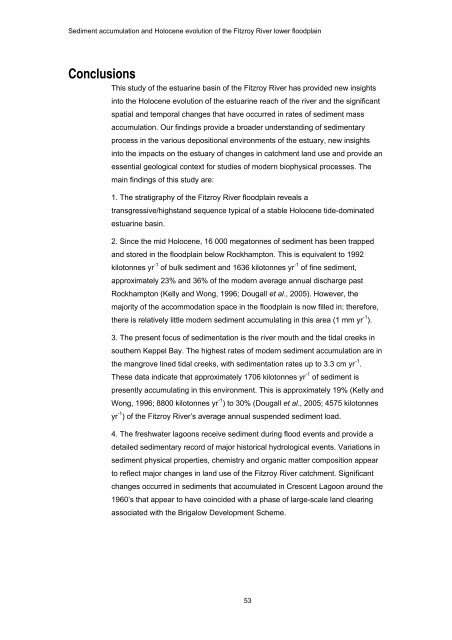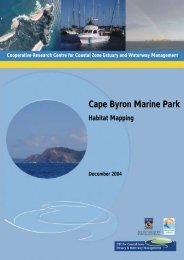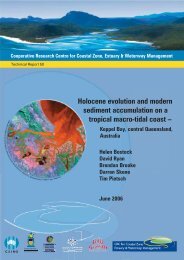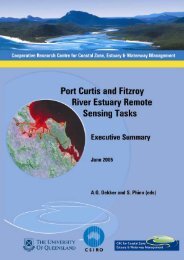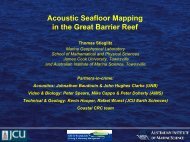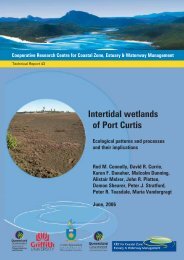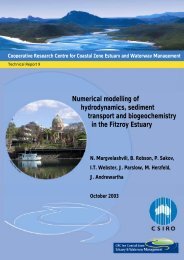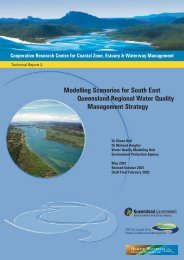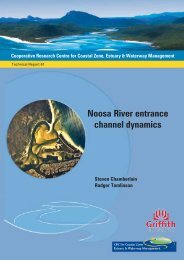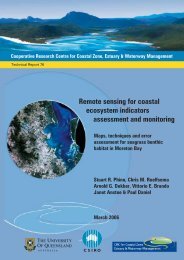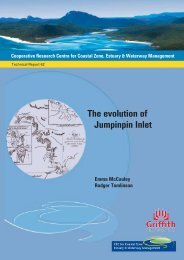Sediment accumulation and Holocene - OzCoasts
Sediment accumulation and Holocene - OzCoasts
Sediment accumulation and Holocene - OzCoasts
Create successful ePaper yourself
Turn your PDF publications into a flip-book with our unique Google optimized e-Paper software.
<strong>Sediment</strong> <strong>accumulation</strong> <strong>and</strong> <strong>Holocene</strong> evolution of the Fitzroy River lower floodplain<br />
Conclusions<br />
This study of the estuarine basin of the Fitzroy River has provided new insights<br />
into the <strong>Holocene</strong> evolution of the estuarine reach of the river <strong>and</strong> the significant<br />
spatial <strong>and</strong> temporal changes that have occurred in rates of sediment mass<br />
<strong>accumulation</strong>. Our findings provide a broader underst<strong>and</strong>ing of sedimentary<br />
process in the various depositional environments of the estuary, new insights<br />
into the impacts on the estuary of changes in catchment l<strong>and</strong> use <strong>and</strong> provide an<br />
essential geological context for studies of modern biophysical processes. The<br />
main findings of this study are:<br />
1. The stratigraphy of the Fitzroy River floodplain reveals a<br />
transgressive/highst<strong>and</strong> sequence typical of a stable <strong>Holocene</strong> tide-dominated<br />
estuarine basin.<br />
2. Since the mid <strong>Holocene</strong>, 16 000 megatonnes of sediment has been trapped<br />
<strong>and</strong> stored in the floodplain below Rockhampton. This is equivalent to 1992<br />
kilotonnes yr -1 of bulk sediment <strong>and</strong> 1636 kilotonnes yr -1 of fine sediment,<br />
approximately 23% <strong>and</strong> 36% of the modern average annual discharge past<br />
Rockhampton (Kelly <strong>and</strong> Wong, 1996; Dougall et al., 2005). However, the<br />
majority of the accommodation space in the floodplain is now filled in; therefore,<br />
there is relatively little modern sediment accumulating in this area (1 mm yr -1 ).<br />
3. The present focus of sedimentation is the river mouth <strong>and</strong> the tidal creeks in<br />
southern Keppel Bay. The highest rates of modern sediment <strong>accumulation</strong> are in<br />
the mangrove lined tidal creeks, with sedimentation rates up to 3.3 cm yr -1 .<br />
These data indicate that approximately 1706 kilotonnes yr -1 of sediment is<br />
presently accumulating in this environment. This is approximately 19% (Kelly <strong>and</strong><br />
Wong, 1996; 8800 kilotonnes yr -1 ) to 30% (Dougall et al., 2005; 4575 kilotonnes<br />
yr -1 ) of the Fitzroy River’s average annual suspended sediment load.<br />
4. The freshwater lagoons receive sediment during flood events <strong>and</strong> provide a<br />
detailed sedimentary record of major historical hydrological events. Variations in<br />
sediment physical properties, chemistry <strong>and</strong> organic matter composition appear<br />
to reflect major changes in l<strong>and</strong> use of the Fitzroy River catchment. Significant<br />
changes occurred in sediments that accumulated in Crescent Lagoon around the<br />
1960’s that appear to have coincided with a phase of large-scale l<strong>and</strong> clearing<br />
associated with the Brigalow Development Scheme.<br />
53


